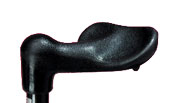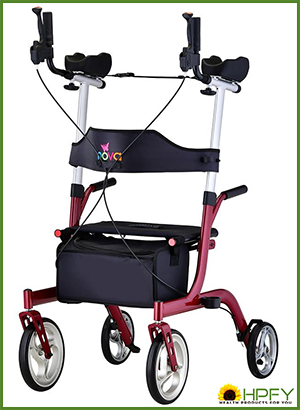
Mobility Canes
Canes are the most basic of all the walking aids for those with mobility issues. They are mostly used to provide added balance when walking but some will also transfer a portion of their weight through the cane as well. Anyone who needs to transfer a lot of their weight should be using crutches or a walker.
There are a variety of cane styles, made of a variety of materials, on the market today. Each of the styles is designed for specific purposes or needs and will have different features.
Height Adjustment
The proper height for a cane is important for the comfort, safety and posture of the user. Generally the top of the cane's handgrips should be at the same height as the user's wrist where it meets the hand when the user is standing as upright as they can. The important thing is there should be a small bend in the user's elbow when using the cane.
Wooden canes without any height adjustment mechanism are usually sold in two lengths (regular around 36" & tall around 40") and are simply cut to the needed length of the user. The popular aluminum canes on the market today will have a height adjustment mechanism of some sort, depending on the model. Once the height of a cane is set, there is usually no need to ever change it unless it is used by multiple people of different heights.
Handle Shape
Round handle
The round handle cane is the standard, original handle style. it works fine for light use by people who do not put a lot of weight on their canes. The grip can be plain wood on wooden canes and plastic or foam on aluminum canes. The foam grip can wear over time but can be replaced for a modest price if needed.
Offset handle
The offset handle was developed for those who put more weight on their canes. The theory is that the offset cane handle will create a straight line from the user's elbow down straight through the cane to the floor. Because this design requires less strength in the user's wrist it is felt that more weight can be comfortably placed on the cane.
"T" handle
The "T" handle on a cane provides a similar effect on the wrist as the offset handle in that it provides more of a straight line from the elbow through the cane to the ground. Although it is not quite as effective as the offset grip handle for canes, it is a popular design for the fancier canes and people really do like the feel of this grip when they are using their canes.

Round Handle

Offset Handle

"T" Handle
Canes with Ergonomic Hand Grips

An ergonomic hand grip on a cane is sometimes called a contour grip or orthopaedic grip depending on who you are talking to but they all have a shape that is designed to fit into the contours of the average hand.
They will be a little different in shape from manufacturer to manufacturer but the common feature is they have more surface for the user's hand to rest on. Because of the larger area the weight the user places on the cane is more distributed and should be more comfortable, for a longer period of time.
Because the shape and size of the ergonomic cane hand grip will vary between models and manufacturer's it is a good idea to try out the cane before purchasing.
How to Use a Cane
Using the standard mobility cane is pretty straight forward. The user holds their cane in the preferred hand, normally on their good side when one leg has a limitation, and walks as normally as possible transferring their weight onto the cane at the same time as the weight is on the opposite leg.
The cane is not supposed to take a lot of the user's weight when walking but some weight to take a bit of the load off a bad leg is okay.


 Online Vendors
Online Vendors  US Online Vendors
US Online Vendors 
